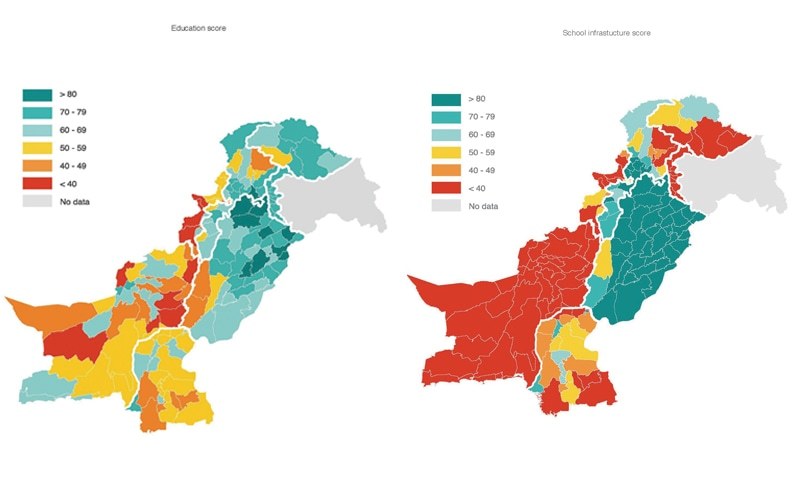State of education not any better this year
A REPORTER — PUBLISHED MAY 08, 2015 06:41AM
WHATSAPP
7 COMMENTS
 PRINT
PRINT
A COMPARISON of the two maps - that depict district education scores (left) and district infrastructure scores (right) - shows that there is a co-relation between availability of resources and the results the produced. — Graphics courtesy Alif Ailaan
ISLAMABAD: Despite a bi-partisan agreement on the importance of pursuing betterment in education, the on-ground realities indicate that the state of education in Pakistan has not improved, but deteriorated slightly from previous years.
This was the crux of the District Education Rankings report 2015, launched by education campaigners Alif Ailaan on Thursday. The event was attended by key figures such as Water and Power Minister Khawaja Asif, State Minister for Education Baleeghur Rehman, ANP’s Afrasiab Khattak, PML-N’s Marvi Memon, PTI’s Shafqat Mehmood and PPP’s Dr Nafisa Shah.
However, there was little to suggest that the powers-that-be were serious about increasing the amount of money the country spends on education, which currently stands at far less than the three per cent of the GDP mark that is a widely accepted benchmark.
It is interesting to note that the Education Policy of 2009, which is currently in force, suggested that at least seven per cent of the GDP be spent on education.
Alif Ailaan report hints at deteriorating standards, AJK overtakes Punjab in rankings
According to Saman Naz, one of the report’s authors, this year’s data indicates a downward trend with regards to learning outcomes and show a slight decline in the general quality of education.
One of the surprises from this year’s report was Azad Jammu and Kashmir, which overtook Punjab to become the second best performing territory behind Islamabad. This, according to Ms Naz, was due to a slight drop in Punjab’s numbers. But given the size difference between the two territories, Ms Naz noted, it would take a very large change to affect Punjab’s numbers, indicating a definite slide in terms of quality.
In terms of primary schools, the rankings are dominated by Punjab, AJK and Gilgit-Baltistan, which despite its remote location, continues to perform consistently well in these rankings. Rawalpindi, Chakwal, Lahore, Haripur and Islamabad constitute the top five.
The middle school rankings, however, are completely dominated by AJK, which has six districts in the top ten. Panjgur district from Balochistan also features in the top five.
Speaking at the launch, Khawaja Asif acknowledged the failure of nearly all past governments to improve the state of education. “We failed to pay attention to education for over 60 years, it is high time that fix the problems,” he said, without specifying what the government planned to do about it.
“District-wise rankings are showing us the mirror,” said PTI MNA Shafqat Mehmood, adding that education should be “beyond politics” and that “political differences should be kept away from the pursuit of education reform”.
Baleeghur Rehman said: “Publishing such rankings is a great idea; it’s a snapshot which not only tells us about our shortcomings, but also points out the areas which need immediate attention.”
“All provinces have greatly improved upon the enrolment numbers, but as a country, we need to make sure that the issues related to enrolment, retention and quality of education receive bipartisan support from all political parties,” he said.
The report also shows the dire state of education in Balochistan and Fata, whose numbers have not changed since last year. The report revealed that none of the tribal areas made it into the top 50, while, nearly all Fata agencies were ranked in the bottom third of the table.
Balochistan’s rankings stand exactly where they were in the year 2014. Quetta was the highest ranked district and the only one in the top 50 districts.
According to the report, Punjab and Azad Jammu and Kashmir (AJK) switched positions this year, with AJK jumping to second spot behind top ranked Islamabad Capital Territory (ICT).
The report illuminates the comparative inequalities prevalent within Pakistan’s federal framework, with the Punjab continuing to provide a superior government school infrastructure to its students, and the highest learning outcomes in the country.
The report said that big change from the 2014 rankings is the upward trend visible in the Khyber Pakhtunkhwa, with this being the first year that the PTI government was in-charge for the entirety of the data collection period. The KP government has managed to show progress through an improved rank, based on considerable improvements in enrolment, retention and importantly, gender parity. KP is still far behind ICT, AJK, and Punjab in many crucial measures, but the improvement is marked.
AJK and Gilgit BAltistan and fast growing in Education .... They might upper punjab in after one or two Decades













